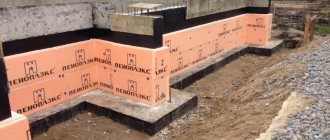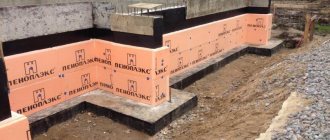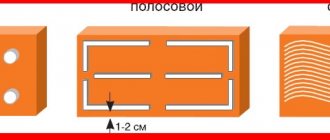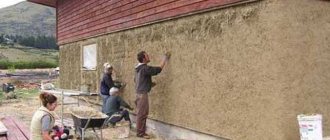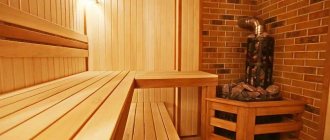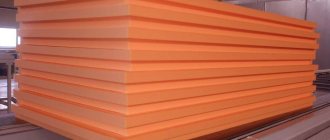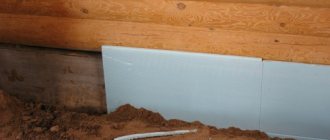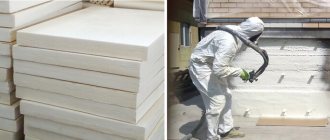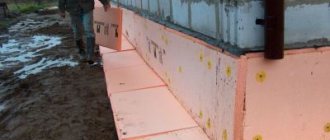The most important task in any construction is the construction of a reliable foundation. The quality of its implementation largely determines how the building will behave during operation. In addition to various works related to finishing the foundation, not least important is its high-quality insulation from the outside.
Let's look at how to insulate the foundation of a house from the outside with your own hands using Penoplex, what you will need for this and the easiest way to do it.
Insulation work is in full swing Source mtdata.ru
General information about Penoplex insulation
This insulation is a domestic development. It is also produced for our conditions. This cannot but rejoice, since the material takes into account all the features of the domestic climate, which is far from mild.
The insulation is based on polystyrene foam, which at high temperatures is subjected to additional foaming - extruded. This operation allows you to significantly increase the already excellent performance characteristics.
The material is very popular not only among independent developers, but also among professional builders. Its main technical characteristics include:
- moisture resistance – no more than 0.5% of the total volume;
- guaranteed service life - more than 50 years;
- compression resistance – 27 tons per square meter;
- operating temperature range – from – 50 to + 75 C.
This information is not exhaustive, since the material also has many positive qualities. Full information can be obtained on the website of the material manufacturer.
Penoplex in packaging Source brus4you.ru
There are many varieties of this insulation on the market, but among them three main varieties can be distinguished:
- "Penoplex-45". This type of insulation has the highest density among all material lines. It is used for insulation of complex building structures that are subject to high loads. These could be airfields, various industrial structures or elements of highways.
- "Penoplex-35". This type of material is often called “Penoplex Foundation”. They are used for insulating monolithic and pile-type foundations. It is also used to insulate the pile base. The material can be laid in both vertical and horizontal directions.
- "Standard". The most widely used type of material, made in the form of flat slabs. It is used for insulating a wide variety of objects, from utility networks and stone walls to insulating wooden floors.
All of the listed insulation modifications are produced in the tongue-and-groove form factor. This allows the elements to be installed as closely as possible to each other and to avoid the formation of gaps between them.
Solid insulation pad for pouring the base of the foundation Source ctkomplekt.ru
The method of cutting the material deserves a special mention. If a special tool is used for this, then professionals advise carrying out cutting work at medium speeds. This will prevent the material from melting and sticking to the cutting parts of the tool.
If you are interested in the question of how to insulate a house with Penoplex, then slabs of medium and smaller thickness will most likely be used. They cut perfectly with an ordinary stationery knife and are neatly broken along the cut line.
What is expanded polystyrene?
This is a snow-white foam material in the form of polystyrene balls, consisting of styrene, which forms its cellular structure, and a foaming agent - pentane. Both constituent components are hydrocarbon compounds obtained as by-products in oil and gas production cycles.
Characteristics of expanded polystyrene:
High heat-protective qualities, since the insulation has low thermal conductivity in the range of 0.029 - 0.037 W/(m•K).- Mechanical strength is ensured by the flexibility of the technological process, when it is possible to set a given strength for specific applications.
- It has special abilities to maintain stable dimensions at air temperatures up to + 80 C.
- Low water absorption - the insulation is not hygroscopic.
- High chemical resistance to salts and alkalis, but can easily be destroyed when treated with solvents.
- High resistance to atmospheric influences and aging processes.
- Low fire resistance - insulation is highly flammable. Modification of this material with fire retardants significantly reduces its flammability.
Choosing a method of insulation
Before deciding how to insulate the basement of a house from the outside with your own hands using Penoplex, you should decide on the method of insulation. There are several methods for carrying out insulation work. As a rule, in practice one of the following three types is used:
- Horizontal type insulation . It is widely used for insulating walls made in a monolithic manner. Shallow foundations of the strip type are no less often insulated. Well suited for laying under a foundation slab as it perfectly protects against freezing on soils prone to heaving.
Insulation areas Source fasad-exp.ru
- Vertical type insulation . With this method, external insulation of the foundation wall is performed. Using the vertical method, insulation of building plinths is also carried out. Fastening to the base is carried out using special mastic. Professionals recommend duplicating the fastening to mastic with plastic dowels.
- Insulation of the blind area . This method allows you to avoid deformation of the poured blind area under the influence of temperature fluctuations. To do this, first the floor pad is prepared according to the technology, then a layer of insulation is laid on it and the concrete mixture is poured.
Possible mistakes
Despite the fact that information about the choice of insulation and the technology for its installation on basement surfaces is publicly available in sufficient quantities on the Internet, in practice, contractors make a large number of mistakes that lead to deformation of not only the heat-protective layer, but also the structural elements of the building.
The biggest mistake that home craftsmen make is saving when choosing the thickness and density of Penoplex. The optimal thickness of base heat insulation sheets for the central regions of Russia is from 80 to 100 mm.
How to eliminate them?
Most errors made during the installation of thermal insulation cannot be corrected ; a complete rework of the base thermal protection system will be required. For example, if solutions not intended for this purpose were used as an adhesive or reinforcing mixture, for example, tile adhesive.
You also can’t save money by mixing glue with sand or adding cement to it for “strength.” It is no less dangerous to use cheap reinforced mesh or violate the technology of its installation. It is better if it is alkali-resistant, with a density of at least 140 g/m2.
A common cause of cracks in the thermal insulation of the base is when the reinforcing mesh is mounted directly on a layer of thermal insulation sheets. It needs to be deepened into the reinforcing layer so that it is 1/3 in the center of the layer. Another common mistake when reinforcing is connecting reinforced mesh sheets without an overlap of 10 cm .
Advantages of external insulation
If your house has not yet been insulated, then the answer to the question - is it necessary to insulate the foundation of the house from the outside with Penoplex - is obvious - it is absolutely necessary.
High-quality external insulation of the foundation will reliably protect it from the negative influences of the external environment and increase indoor comfort. In general, it is recommended to carry out such work at the stage of erecting the foundation of the building.
If we summarize the main advantages of external insulation of the foundation and basement of a building, they look like this:
- increased resistance to temperature changes;
The trench must be of sufficient width Source modernizacija.ru
- it becomes possible to maintain a constant temperature in the basement regardless of the time of year;
- a reliable barrier is created that prevents groundwater and rainwater from penetrating into the basement;
- The service life of the foundation increases significantly due to the reliable protection of concrete from the effects of low temperatures and moisture.
Thermal insulation of the foundation has another undeniable advantage - the ability to move the dew point. This is the moment when water vapor condenses into water. In winter, the difference in temperature inside and outside the room leads to the appearance of droplets of moisture. They gradually destroy the finish and infect the walls with fungi.
Why insulate the foundation?
During operation, the structural elements of the underground parts of the building experience significant physical stress from soil pressure and temperature changes, which can lead to displacement of the foundation structure and the formation of cracks in its structure.
Foundations and basement floors account for about 10% of all heat loss in a building. Insulation of the buried part of the building reduces heat leakage, protects the foundation structure from freezing and avoids the appearance of dampness, mold and mildew.
Particular attention to the issue of thermal insulation during the construction of foundations should be paid in regions with deep soil freezing.
Heaving is an increase in soil volume during the process of freezing. This feature is explained by the presence of a large amount of moisture in the soil. When the liquid freezes, it crystallizes, which significantly affects the volume of the soil. If the soil contains excessive amounts of moisture, heaving is inevitable. This process is uneven - the soil under different parts of the foundation can rise to different heights. This can lead to partial or complete destruction of the foundation of the house.
Calculation of the required material thickness and calculation of parameters
Of course, the answer to the question - how to properly insulate the foundation of a private house with Penoplex - is associated with certain calculations. The first thing that needs to be done is to determine the exact thickness of the material that is optimally suited to a specific climate zone.
Insulation at the construction stage Source rock-n-dom.ru
Firstly, this will make it possible to make the insulation of the highest quality possible, and secondly, you will not overpay for excess material.
Determining the optimal material thickness
When deciding what thickness of Penoplex to choose for insulating the foundation, first of all, you should pay attention to the data that the manufacturer indicates on the packaging. The prescribed parameters refer to the minimum recommended values for different climatic zones.
For example, in areas where sub-zero temperatures can reach thirty degrees or below, the minimum recommended thickness of the material is ten centimeters. As for the modification of the insulation itself, professionals recommend purchasing “Penoplex-45” or “Foundation”.
The form factor of such plates is sixty by one hundred and twenty centimeters. The weight of one slab does not exceed two and a half kilograms. The thickness of the material varies and is available in the range from two to ten centimeters.
Options
As mentioned above, the manufacturer puts general data on the minimum recommended thickness of the material on the packaging. However, these indicators are averaged, and in order to get the most accurate result it is necessary to perform simple calculations.
The insulation has been completed, but the final finishing has not been completed. Source www.penoplex.ru
See also: Catalog of companies that specialize in finishing materials and foundations.
They are performed using the following formula:
V=v1/a1+v2/a2
Wherein:
- a1 – thermal conductivity of the insulated material;
- a2 – thermal conductivity of insulation;
- V – regional resistance to heat transfer in a particular region;
- v1 – value indicating how thick the foundation is;
- v2 is a value indicating how thick the slab is.
Now all that remains is to look into the reference books and look up the values for the quantities “V”, as well as “a1”. It is necessary to find a value that corresponds to the value “v2”. To do this, a simple substitution of known data into the formula is done and simple mathematical calculations are performed.
The result must be rounded up. This will allow you to purchase with a small reserve, which will not be superfluous and will have little effect on the overall price of the insulation.
All calculations for the required amount of material are performed based on the area of the insulation. Penoplex slabs have a standard area of seventy-two hundredths of a square meter.
When thinking about how to insulate a house from the outside with Penoplex with your own hands, do not forget the advice of experts to do two-layer insulation. The second layer is applied to the first with a slight offset to cover the seams of the lower layer.
The most popular manufacturers, packaging price
In Russia there are about a hundred enterprises of varying capacities that produce polystyrene foam insulation boards.
Professionals, when purchasing base insulation in a retail chain, choose products from market leaders. This will serve as a guarantee of the quality and durability of the thermal insulation coating of the base.
List of popular polystyrene foam manufacturers.
TechnoNikol
Russian manufacturer, its facilities are located in 7 CIS countries and the EU. "TechnoNikol XPS" with a thermal conductivity of 0.028 W/(m*K) , is produced in packages of 4 slabs, dimensions 100x580x1180 mm, total area of 2.74 m2, packaging cost - 1200 rubles.
URSA
A product of a Spanish concern, production is also located in Russia in Serpukhov. “URSA XPS G4”, with a thermal conductivity of 0.030 W/(m*K), package of 4 slabs with dimensions 100x600x1180 mm, total area of 2.83 m2, packaging cost - 1500 rubles.
Penoplex
Produced by a company in St. Petersburg. “Penoplex Foundation”, with a thermal conductivity of 0.030 W/(m*K) , package of 4 slabs with dimensions 100x585x1185mm, total area of 2.77 m2, package cost 1540 rubles.
Theplex
Nizhny Novgorod plant are produced in the form of slabs. “Teplex 35”, with a thermal conductivity of 0.030 W/(m*K), a package of 4 slabs with dimensions 100x600x1200 mm, a total area of 2.88 m2, packaging cost - 1350 rubles.
Polyspen
The plant is located in Kirov. This is foamed polystyrene, which is produced by extrusion. “Polyspen 35 G4” has a thermal conductivity of 0.028 W/(m*K) , the package consists of 7 sheets measuring 50x600x1200mm, with a total area of 7 m2, the cost of packaging is 950 rubles.
Practical implementation of insulation work
Before insulating the facade of a house with Penoplex with your own hands, you need to carefully think through and prepare everything. Purchase insulation and consumables, select the appropriate tool.
Consumables and tools
Consumable materials and tools for carrying out insulation work are required:
- reinforcing mesh made of polymer materials or metal;
- primer with high penetrating ability;
- container for mixing mastic;
- stationery knife;
- brush for applying mastic;
- mastic for fastening insulation;
- polyurethane foam;
- mixer attachment for drill;
- perforator;
- plastic dowels for duplicating fastening on mastic;
- rule;
- construction trowel;
- level;
- insulation of the required thickness
- metal brush;
- putty knife.
Everything is ready to fill the blind area Source build-experts.ru
How to properly insulate with your own hands?
In order to insulate the base from the inside you need:
Completely clean the base walls from dirt, dust, debris, as well as concrete deposits that may have remained after pouring.
This can be done using an angle grinder (grinder) with a grinding disc and an air compressor.During work, it is recommended to use a respirator, as well as other protection, as the process will be very dusty.
- Level the walls using primer or concrete mortar.
To do this, spread the mixture onto the surface of the base, then use a wide spatula or a rule to level the layer. To improve strength, it is recommended to use reinforcing mesh (especially when the walls differ by more than 2.5 cm). Using a spatula, it is embedded in a layer of mortar, after which the outer surface is trimmed. If the foundation has a flat surface, then this step can be skipped. - Apply a preliminary layer of waterproofing. To do this, you can use bitumen mastic (primer). It must be applied so that the layer covers all irregularities. This material can replace a layer of primer or cement mortar that is used for leveling.
- Begin installing the base layer of waterproofing.
It is recommended to use rolled fused material, for example, roofing felt. Using a burner and a gas (propane) cylinder, the insulation surface is heated until the protective layer melts. It is recommended that two people do this procedure: one heats it, and the other rolls it out and presses the roll against the wall. Insulation is applied from the bottom of the foundation to the top. The overlap between layers should be 100-150 mm. - Mount penoplex sheets on the wall using a special glue that is used for insulation work or water-based bitumen mastic (organic solvents, such as alcohol, acetone or benzene, destroy the structure of penoplex).
The glue must be applied so that after pressing the plate the contact surface is at least 40%. If the wall has a flat surface, then a notched trowel can be used for application. Also, the adhesive mixture must be applied away from the edges so that after installation it does not protrude (this will interfere with the rest of the slabs).In some cases, penoplex can be fixed to heated roofing material. It is recommended to install the slabs so that their tongue-and-groove joints fit tightly together.
- If insulation is carried out for that part of the foundation that will be covered with earth, then additional fastening in the form of “fungi” dowels is not required, since it will only cause damage. For the entire space that is above ground level, such fastenings are necessary. It should be fixed to the dowels only after the glue has completely dried.
- After this you need to carry out the final finishing.
To do this, using glue (cement-based) on which the foam boards are glued, as well as a spatula, apply a layer of the mixture to the surface of the insulation. To make the finish stronger and protect it from rodents, you need to embed a reinforcing mesh made of metal or fiberglass into the solution. The surface of the mixture must be leveled and allowed to dry completely. - After this, you can smooth out the unevenness with sandpaper or an angle grinder with a grinding attachment in order to install the exterior finish (if this is required, for example, for the basement).
Video description
Watch the video - insulating the foundation of a house and basement:
This is done as follows:
- At a distance of about twenty-five centimeters to the surface, a ten-centimeter sand bed is poured. Tamping is in progress.
- The bottom is covered with roofing felt and the overlapping sheets are coated with bitumen.
- Thermal insulation sheets are laid with the joints blown in with polyurethane foam.
- Further work on filling the blind area is carried out according to the generally accepted scheme.
- The base is covered according to personal preferences.
Blind area
To construct a blind area along the foundation, we dig a shallow trench 30-35 cm deep and 70-100 cm wide. If backfilling was performed, then simply leave 30-35 cm at the top to the ground level of the uncovered foundation, and then the trench is expanded to the required size.
At the bottom of the prepared trench, with careful tamping, we arrange a “cushion” of 10-15 cm of sand or sand-gravel mixture. Rolled waterproofing material is laid over the “cushion”, with the joints carefully connected. After this, there can be two options: reinforced concrete is poured over the waterproofing and a blind area is installed, or foam plastic is first laid, and then the blind area is laid over it. The second option, although more expensive, provides additional thermal insulation of the foundation, especially in the case where the underground part was not insulated.
Installation of insulated blind area
For strength, the blind area is reinforced with longitudinal and transverse reinforcement with a diameter of 8-10 mm or a metal mesh with a cross-section of 4-6 mm. To drain water, its surface is inclined, with a slight slope away from the house.
